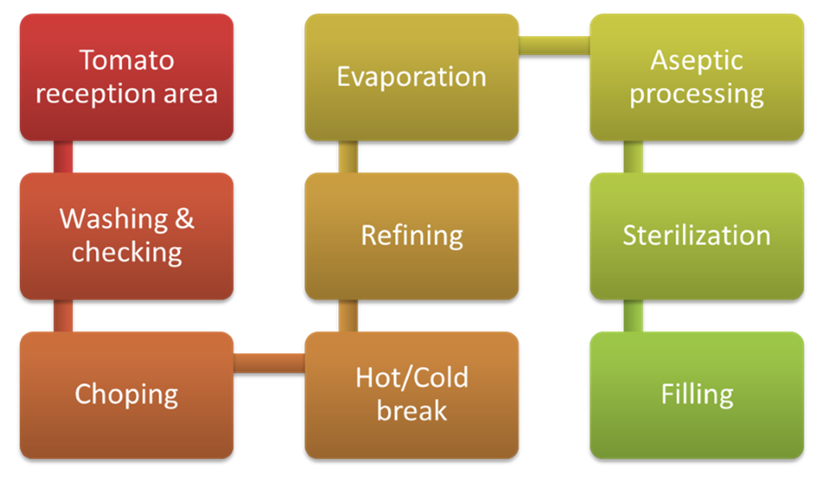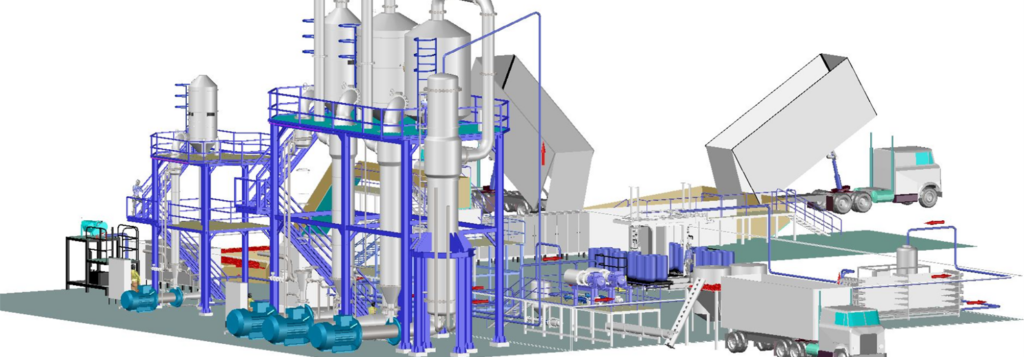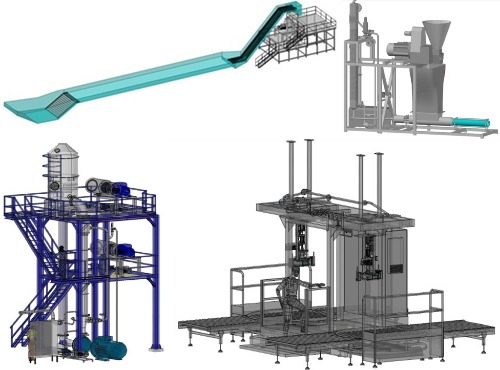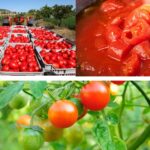Tomatoes, native to the Americas, are vegetables rich in carbohydrates and minerals, as well as antioxidants such as lycopene. Today they are the most widely grown vegetable around the world and are processed in a variety of ways.
They are used for making sauces, concentrates, juices, canned products and gazpacho.
Pomodoro Production Processes
Sauces
The tomatoes are washed to remove stones, dirt and contaminants from the field. They are then crushed using two different methods:
Hot Crushing: In this method, a portion of the crushed and heated tomatoes is recirculated along with the fresh tomato feed, causing them to break down while hot. Cold Crushing: Here tomatoes are crushed directly using high-capacity sieves, removing skins and seeds in one operation.
Each method produces different flow or viscosity characteristics. The Hot Break procedure produces higher viscosity because it deactivates enzymes more quickly, preventing loss of viscosity.
The crushed seedless tomato is then concentrated using forced circulation evaporators, reaching concentrations of 30-32 brix.
It then undergoes pasteurization in high-pressure tubular equipment. Because of the high viscosity of the concentrate, these machines are designed to work at pressures up to 300 bar, pumped by piston pumps similar to homogenizers.
Pasteurized products are stored by filling them in aseptic bags, typically in 240 kg quantities, contained in metal drums or cardboard boxes.
These sauces are mixed with various ingredients such as peppers, mustard, chilies and herbs, resulting in thousands of different types around the world, many of them characteristic of various countries.

Processing of Tomato Concentrate
This is the largest tomato industry because although tomatoes are grown year-round in greenhouses, they are mainly distributed fresh, and processing takes place mainly during the summer season for about three months. Therefore, industrial storage is necessary for year-round use.
Processing plants of this type can achieve large daily throughputs of up to 10,000 tons.
Cans and Jars
The processing of whole tomatoes for domestic use is significant in industry.
Crushed tomatoes, whole tomatoes, and diced tomatoes are used in cans with acid-based liquids, either fried on their own or mixed with other vegetables, resulting in countless mixtures and presentations depending on the manufacturer.

Processed Tomato
In general, the process begins with washing and preliminary sorting of tomatoes. From here, tomatoes are peeled using different methods:
Thermo-Physical Procedures: The tomato peel is removed by contact with live steam or hot water, then removed using rubber rollers, with possible manual repair if high quality is desired.
Chemical Procedures: Here, the peel is removed by spraying caustic soda. This method offers a better finish but generates more effluent in wastewater treatment.
Next, volumetric fillers fill the jars or cans, and they are weighed before adding the liquid that fills them completely.
Once sealed, the tomatoes are sterilized in autoclaves or continuous pasteurizers, depending on the pH of the liquid. After cooling, they are stacked and labeled.
Gazpacho and Juices
The processing of gazpacho is special because it uses high-quality fresh tomatoes, usually from greenhouses available year-round.
Cold extraction is used, and it is mixed with other vegetables such as peppers and cucumbers to create the base of Mediterranean gazpacho. Oils, vinegars and additives are added later.
For packaging, it is pasteurized using flax equipment that preserves the organoleptic qualities of the natural fruit and is packaged aseptically or refrigerated to maintain its optimal qualities.
The best results are achieved with carton packaging, as these technologies allow cold packing, which, combined with linen treatment, ensures high quality and fresh vegetable flavors.
Tomato Production Machinery: Expert Solutions for the Production of Tomato Products
At MachinePoint, we supply used tomato processing machinery. Depending on the type of product to be made, different equipment is needed. The most common equipment in a manufacturing process includes:
- Tomato Receiving, Washing and Sorting Area: This area includes roller conveyors or belt conveyors for handling fresh tomatoes. It also includes washing machines and automated sorting devices.
- Receiving and Washing Lines: These lines typically include receiving hoppers, bucket elevators, and immersion or spray washers to ensure clean tomatoes.
- Peeling Lines: Tomato peeling machines use special rollers or blades to efficiently remove the skin of tomatoes.
- Cubed Tomato Production Lines: These lines are equipped with cutters and blades to obtain uniform tomato cubes.
- Tomato Juice Extraction Lines: This stage involves near and extraction systems designed to obtain tomato juice effectively.
- Refining: Sieves and filters are used to remove impurities and achieve a smooth texture.
- Hot/Cold Break Zone: This area can include heating or cooling tanks and stirring systems to control tomato temperature as needed.
- Evaporation: Vacuum evaporators are used to remove excess water from the tomato mixture and concentrate the product.
- Sterilization: Autoclaves or continuous sterilizers are used to subject products to high temperatures and pressures to ensure preservation and safety.
- Aseptic Filling: This machine hermetically fills and seals containers to maintain product sterility.
- Supplementary Equipment: These may include cooling towers, water filtration systems, and cleaning-in-place (CIP) systems for automated equipment cleaning.






